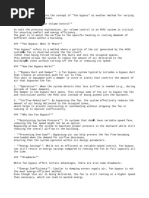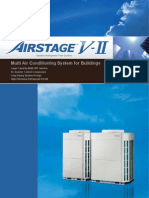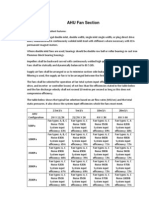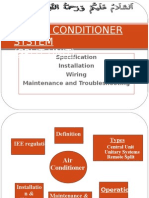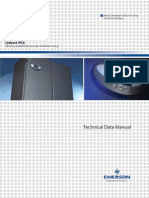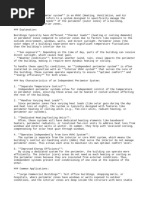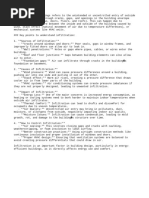0 ratings0% found this document useful (0 votes)
1 viewsESP
ESP
Uploaded by
osama316aliCopyright:
© All Rights Reserved
Available Formats
Download as TXT, PDF, TXT or read online from Scribd
ESP
ESP
Uploaded by
osama316ali0 ratings0% found this document useful (0 votes)
1 views1 pageCopyright
© © All Rights Reserved
Available Formats
TXT, PDF, TXT or read online from Scribd
Share this document
Did you find this document useful?
Is this content inappropriate?
Copyright:
© All Rights Reserved
Available Formats
Download as TXT, PDF, TXT or read online from Scribd
Download as txt, pdf, or txt
0 ratings0% found this document useful (0 votes)
1 views1 pageESP
ESP
Uploaded by
osama316aliCopyright:
© All Rights Reserved
Available Formats
Download as TXT, PDF, TXT or read online from Scribd
Download as txt, pdf, or txt
You are on page 1of 1
The **external static pressure (ESP)** in an HVAC system refers to the **resistance
to airflow** that the fan must overcome to deliver the desired volume of air
through the system. It is an important parameter in the design and operation of
HVAC systems, particularly for packaged units and air handlers.
### **What ESP Includes:**
ESP accounts for the pressure losses due to external components outside of the HVAC
unit itself, such as:
1. **Ductwork**:
- Supply ducts.
- Return ducts.
2. **Filters**:
- Return air filters.
- Any additional filters installed in the duct system.
3. **Dampers**:
- Balancing dampers or motorized dampers in the duct system.
4. **Registers, Grilles, and Diffusers**:
- Airflow restrictions caused by these terminal devices.
5. **Accessories**:
- External coils, silencers, or other equipment installed outside the unit.
---
### **Why ESP Matters:**
1. **Fan Sizing and Selection**:
- The fan in a packaged unit must be capable of handling the ESP at the required
airflow (CFM or L/s). If the ESP exceeds the fan's capacity, it will lead to
inadequate airflow.
2. **System Performance**:
- High ESP can reduce the efficiency of the HVAC system, causing poor
cooling/heating performance and increased energy consumption.
3. **Troubleshooting**:
- Measuring ESP helps diagnose airflow issues. For instance:
- High ESP might indicate clogged filters, undersized ducts, or blocked
grilles.
- Low ESP might suggest air leakage or missing duct components.
---
### **Key Points to Remember:**
- **Total Static Pressure (TSP)**: The sum of internal and external static
pressures.
- Internal components include coils, blowers, and heat exchangers within the
unit.
- ESP focuses only on external components.
- **Rated ESP**: Manufacturers specify the maximum ESP the unit's fan can handle.
Operating beyond this limit can overload the fan, reduce airflow, or cause system
failure.
By measuring ESP, you ensure that the system operates within its designed
parameters, maintaining efficiency, comfort, and reliability. Let me know if you'd
like detailed help with calculating ESP or interpreting specific HVAC scenarios!
You might also like
- Ruud UMPC Series ManualDocument8 pagesRuud UMPC Series ManualisothermNo ratings yet
- Vapor Cycle Air Conditioning System TR-134 SMDocument33 pagesVapor Cycle Air Conditioning System TR-134 SMDavid Bond100% (1)
- 25 - E65-66 IhkaDocument55 pages25 - E65-66 IhkaKent WaiNo ratings yet
- Introduction to the simulation of power plants for EBSILON®Professional Version 15From EverandIntroduction to the simulation of power plants for EBSILON®Professional Version 15No ratings yet
- AHU ECONOMISERDocument2 pagesAHU ECONOMISERosama316aliNo ratings yet
- AC_DetailsDocument2 pagesAC_DetailsAJAY KUMARNo ratings yet
- Module 2 PPTDocument22 pagesModule 2 PPTAkperheNo ratings yet
- Chiller pass arrangmenetsDocument2 pagesChiller pass arrangmenetsosama316aliNo ratings yet
- # Air Conditioning - General:: Note For CPC Manual ModeDocument30 pages# Air Conditioning - General:: Note For CPC Manual Modejontis jasoliyaNo ratings yet
- Dumping excess supply airDocument2 pagesDumping excess supply airosama316aliNo ratings yet
- CompressedAirSystem PPDocument7 pagesCompressedAirSystem PPZHANG XIAO LI (Linco)No ratings yet
- Manufacturing Air Conditioners (ACs) InvolvesDocument2 pagesManufacturing Air Conditioners (ACs) Involvessumitpython.41No ratings yet
- Particular HVACDocument49 pagesParticular HVACAdnan Khan100% (1)
- Comprehensive Computer Hardware Maintenance GuideDocument3 pagesComprehensive Computer Hardware Maintenance GuideEllaNo ratings yet
- Typical P&ID Arrangement For Centrifugal Compressor SystemsDocument2 pagesTypical P&ID Arrangement For Centrifugal Compressor SystemsajaysapruNo ratings yet
- fan bypass methodDocument2 pagesfan bypass methodosama316aliNo ratings yet
- Split Air Conditioner Learning SimulationDocument19 pagesSplit Air Conditioner Learning Simulationkablas100% (1)
- Mitsubishi PEHD-3EKA3.UK Service ManualDocument32 pagesMitsubishi PEHD-3EKA3.UK Service Manualspam.alamierdaNo ratings yet
- P & ID in CH definitionDocument2 pagesP & ID in CH definitionosama316aliNo ratings yet
- hp26 Eng HandbookDocument58 pageshp26 Eng HandbookxbinfluxNo ratings yet
- AirstageDocument76 pagesAirstagedaviko313No ratings yet
- Hvac Systems: UNIT-2 Building Serivces and Intergration - IDocument31 pagesHvac Systems: UNIT-2 Building Serivces and Intergration - Ivishnu_2008100% (1)
- HVAC Handbook CARRIER New Edition Part 12 Water and DX System PDFDocument23 pagesHVAC Handbook CARRIER New Edition Part 12 Water and DX System PDFalejandro100% (1)
- Mechanical Design TheoryDocument9 pagesMechanical Design TheoryJoseph DavidNo ratings yet
- DeGATECH_Wet_Scrubber_ManualDocument3 pagesDeGATECH_Wet_Scrubber_Manualdheeraj.lohar018No ratings yet
- Revised PPT For Online Lecture 6 HVAC-Types of SystemsDocument22 pagesRevised PPT For Online Lecture 6 HVAC-Types of SystemsAmey Deshmukh100% (1)
- Compressed Air SystemDocument5 pagesCompressed Air Systemchhoan.nhunNo ratings yet
- Compu Mate Brochure v2Document11 pagesCompu Mate Brochure v2pabloabelgilsotoNo ratings yet
- York EspecificacionesDocument34 pagesYork EspecificacionesblasspascalNo ratings yet
- Compressor Symbol Centrifugal CompressorDocument3 pagesCompressor Symbol Centrifugal CompressorPriscilla VidyaNo ratings yet
- Air Condationing FinalDocument40 pagesAir Condationing FinalPeterson muchiriNo ratings yet
- Fan_DetailsDocument2 pagesFan_DetailsAJAY KUMARNo ratings yet
- Lecture No.5 (Air Handling Unit)Document9 pagesLecture No.5 (Air Handling Unit)Mohsen HassanNo ratings yet
- AC - Air ConditioningDocument185 pagesAC - Air ConditioningHari Prasad Ambaripeta100% (1)
- The ALCO Controls EC3-75xDocument8 pagesThe ALCO Controls EC3-75xMaria DazaNo ratings yet
- Mechanical Specifications For VillasDocument30 pagesMechanical Specifications For VillasdreamagiczNo ratings yet
- ACMV SystemDocument45 pagesACMV SystemnuraisyahnadiasabriNo ratings yet
- Air Ejector PDFDocument66 pagesAir Ejector PDFSebastianNo ratings yet
- AHU FansDocument14 pagesAHU Fansmirali74No ratings yet
- Reusing refrigeration lineDocument2 pagesReusing refrigeration lineosama316aliNo ratings yet
- 2 Gill APST201 AC ComponentsDocument35 pages2 Gill APST201 AC Componentscibaya4619No ratings yet
- Refr Sys DesignDocument13 pagesRefr Sys Designعبدالله عمرNo ratings yet
- CH - 10 Air Condition SystemxxxDocument48 pagesCH - 10 Air Condition SystemxxxvespacuteNo ratings yet
- 67035fd97fc09cdae841edd9 11969924274Document2 pages67035fd97fc09cdae841edd9 11969924274Don BoscoNo ratings yet
- Cooling System Design Specification NotesDocument3 pagesCooling System Design Specification Notesdanena88No ratings yet
- Pnematics M 2Document21 pagesPnematics M 2idigitiNo ratings yet
- Liebert PEX TDM 20101207 PDFDocument67 pagesLiebert PEX TDM 20101207 PDFlouie mabiniNo ratings yet
- 8.0 RAC Air Conditioning Systems and Duct Design-1Document16 pages8.0 RAC Air Conditioning Systems and Duct Design-1Aasif Amin ThokerNo ratings yet
- 10 GS-08 - Air Conditioning - Ventilation SystemDocument111 pages10 GS-08 - Air Conditioning - Ventilation SystemshivvaramNo ratings yet
- Size HydraulicsDocument2 pagesSize HydraulicsMuzz ZamilNo ratings yet
- NEC IPX Configuration Guide Issue 1Document58 pagesNEC IPX Configuration Guide Issue 1Alexander MoralesNo ratings yet
- Liebert Intelecool2: 1.0 GeneralDocument5 pagesLiebert Intelecool2: 1.0 GeneraljairofgfNo ratings yet
- User Manual: Shenzhen Envicool Technology Co., LTDDocument31 pagesUser Manual: Shenzhen Envicool Technology Co., LTD허광수No ratings yet
- Installation and Operation Instructions For Custom Mark III CP Series Oil Fired UnitFrom EverandInstallation and Operation Instructions For Custom Mark III CP Series Oil Fired UnitNo ratings yet
- Oral and Practical Review: Reflections on the Part 147 CourseFrom EverandOral and Practical Review: Reflections on the Part 147 CourseNo ratings yet
- Radio Shack TRS-80 Expansion Interface: Operator's Manual Catalog Numbers: 26-1140, 26-1141, 26-1142From EverandRadio Shack TRS-80 Expansion Interface: Operator's Manual Catalog Numbers: 26-1140, 26-1141, 26-1142No ratings yet
- Contemporary Anaesthetic Equipments.: An Aid for Healthcare Professionals.From EverandContemporary Anaesthetic Equipments.: An Aid for Healthcare Professionals.No ratings yet
- AnemometerDocument1 pageAnemometerosama316aliNo ratings yet
- Independent Perimeter SystemsDocument2 pagesIndependent Perimeter Systemsosama316aliNo ratings yet
- Building Envelpore Roof insulationDocument3 pagesBuilding Envelpore Roof insulationosama316aliNo ratings yet
- SFP CalculationDocument3 pagesSFP Calculationosama316aliNo ratings yet
- Package unit stagesDocument2 pagesPackage unit stagesosama316aliNo ratings yet
- Duct Structural IntegrityDocument2 pagesDuct Structural Integrityosama316aliNo ratings yet
- IEERDocument5 pagesIEERosama316aliNo ratings yet
- T1 - T3 Cooling stagesDocument1 pageT1 - T3 Cooling stagesosama316aliNo ratings yet
- AHU VALVESDocument3 pagesAHU VALVESosama316aliNo ratings yet
- RELATION AHU VFD AND CHW VFDDocument2 pagesRELATION AHU VFD AND CHW VFDosama316aliNo ratings yet
- Difference between gross and net btu-hDocument2 pagesDifference between gross and net btu-hosama316aliNo ratings yet
- ESP measurement through fluke 922Document2 pagesESP measurement through fluke 922osama316aliNo ratings yet
- DRV VS PICVDocument2 pagesDRV VS PICVosama316aliNo ratings yet
- 2-way valve & 3-way valveDocument4 pages2-way valve & 3-way valveosama316aliNo ratings yet
- Decoupler in CHW NetworkDocument1 pageDecoupler in CHW Networkosama316aliNo ratings yet
- DRV & BF ValveDocument3 pagesDRV & BF Valveosama316aliNo ratings yet
- infiltrationDocument1 pageinfiltrationosama316aliNo ratings yet
- Checking chiller bacnet ipDocument1 pageChecking chiller bacnet iposama316aliNo ratings yet
- Blower door testDocument1 pageBlower door testosama316aliNo ratings yet
- Duct insulationDocument2 pagesDuct insulationosama316aliNo ratings yet
- LED BATTEN INDUSTRIAL PHI 1-38WDocument3 pagesLED BATTEN INDUSTRIAL PHI 1-38Wosama316aliNo ratings yet
- Chiller plant Health reportDocument2 pagesChiller plant Health reportosama316aliNo ratings yet
- LED-PANEL-60-60 cm-1-36WDocument3 pagesLED-PANEL-60-60 cm-1-36Wosama316aliNo ratings yet
- single duct zoned vav systemDocument1 pagesingle duct zoned vav systemosama316aliNo ratings yet















